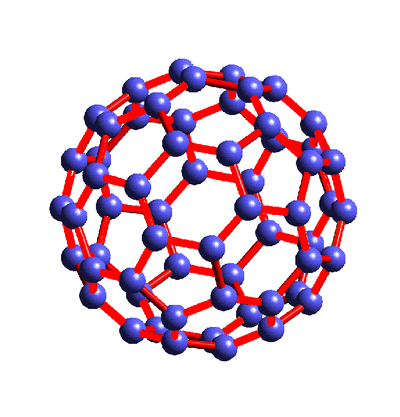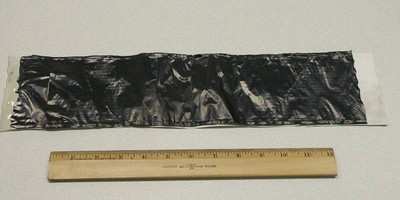Weird Name... But Your Next Plane Could Be Made From
It
Sir Harold Kroto, now a professor and scientist with FSU's
department of chemistry and biochemistry, along with colleagues
Robert Curl Jr. and Richard E. Smalley, shared the 1996 Nobel Prize
in Chemistry for their discovery of Buckminsterfullerene --
nicknamed "buckyballs" for the molecules' spherical shape.

Their discovery has led to a revolution in the fields of
chemistry and materials science -- and directly contributed to the
development of "buckypaper," which owes its name to
Buckminsterfullerene, or Carbon 60 -- a type of carbon molecule
whose powerful atomic bonds make it twice as hard as a diamond.
Buckypaper is made from carbon nanotubes -- amazingly strong
fibers about 1/50,000th the diameter of a human hair that were
first developed in the early 1990s. Researchers at Smalley's
laboratory inadvertently found that the tubes would stick together
when disbursed in a liquid suspension and filtered through a fine
mesh, producing a thin film.
Working with a material 10 times lighter than steel -- but 250
times stronger -- would be a dream come true for any engineer. If
this material also had amazing properties that made it highly
conductive of heat and electricity, it would start to sound like
something out of a science fiction novel.
Yet one Florida State University research group, the Florida
Advanced Center for Composite Technologies (FAC2T), is working to
develop real-world applications for just such a material.
Ben Wang -- a professor of industrial engineering at the
Florida A&M University-FSU College of Engineering in
Tallahassee, FL, who serves as director of FAC2T -- is widely
acknowledged as a pioneer in the growing field of nano-materials
science. His main area of research, involving the extraordinary
material known as buckypaper, has shown promise in a variety of
applications.
The US military has shown a keen interest in the military
applications of Wang's research; in fact, the Army Research Lab
recently awarded FAC2T a $2.5-million grant, while the Air Force
Office of Scientific Research awarded $1.2 million.
"At FAC2T, our objective is to push the envelope to find out
just how strong of a composite material we can make using
buckypaper," Wang said. "In addition, we're focused on developing
processes that will allow it to be mass-produced cheaply."
So far, the Florida State institute has been able to produce
buckypaper with half the strength of the best existing composite
material, known as IM7. Wang expects to close the gap quickly, the
Associated Press reported. "By the end of next year we should have
a buckypaper composite as strong as IM7, and it's 35 percent
lighter," Wang said.
Carbon nanotubes are already beginning to be used to strengthen
tennis rackets and bicycles, but in small amounts. The epoxy resins
used in those applications are 1 to 5 percent carbon nanotubes,
which are added in the form of a fine powder. Buckypaper, which is
a thin film rather than a powder, has a much higher nanotube
content — about 50 percent.
Among the possible uses for buckypaper that are being researched
at FAC2T:
- If exposed to an electric charge, buckypaper could be used to
illuminate computer and television screens. It would be more
energy-efficient, lighter, and would allow for a more uniform level
of brightness than current cathode ray tube (CRT) and liquid
crystal display (LCD) technology.
- As one of the most thermally conductive materials known,
buckypaper lends itself to the development of heat sinks that would
allow computers and other electronic equipment to disperse heat
more efficiently than is currently possible. This, in turn, could
lead to even greater advances in electronic miniaturization.
- Because it has an unusually high current-carrying capacity, a
film made from buckypaper could be applied to the exteriors of
airplanes. Lightning strikes then would flow around the plane and
dissipate without causing damage.
- Films also could protect electronic circuits and devices within
airplanes from electromagnetic interference, which can damage
equipment and alter settings. Similarly, such films could allow
military aircraft to shield their electromagnetic "signatures,"
which can be detected via radar.
FAC2T "is at the very forefront of a technological revolution
that will dramatically change the way items all around us are
produced," said Kirby Kemper, FSU's vice president for Research.
"The group of faculty, staff, students and post-docs in this center
have been visionary in their ability to recognize the tremendous
potential of nanotechnology. The potential applications are
mind-boggling."

FSU has four US patents pending that are related to its
buckypaper research. In addition to his academic and scientific
responsibilities, Wang recently was named FSU's assistant vice
president for Research. In this role, he will help to advance
research activities at the College of Engineering and throughout
the university.
"I look forward to bringing researchers together to pursue
rewarding research opportunities," Wang said. "We have very
knowledgeable and talented faculty and students, and I will be
working with them to help meet their full potential for advancement
in their fields."
 Airbus Racer Helicopter Demonstrator First Flight Part of Clean Sky 2 Initiative
Airbus Racer Helicopter Demonstrator First Flight Part of Clean Sky 2 Initiative Diamond's Electric DA40 Finds Fans at Dübendorf
Diamond's Electric DA40 Finds Fans at Dübendorf ANN's Daily Aero-Term (04.23.24): Line Up And Wait (LUAW)
ANN's Daily Aero-Term (04.23.24): Line Up And Wait (LUAW) NTSB Final Report: Extra Flugzeugbau GMBH EA300/L
NTSB Final Report: Extra Flugzeugbau GMBH EA300/L Classic Aero-TV: 'Never Give Up' - Advice From Two of FedEx's Female Captains
Classic Aero-TV: 'Never Give Up' - Advice From Two of FedEx's Female Captains




